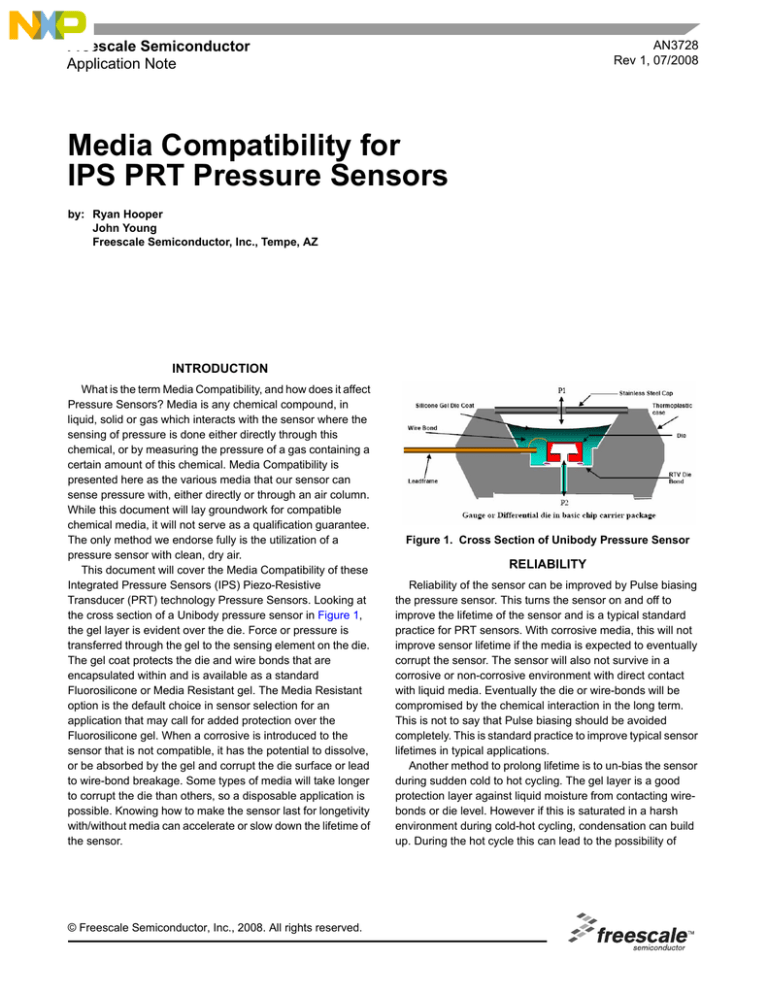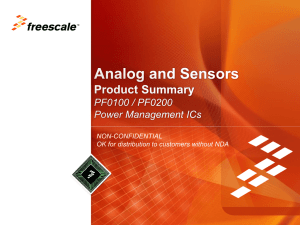
AN3728
Rev 1, 07/2008
Freescale Semiconductor
Application Note
Media Compatibility for
IPS PRT Pressure Sensors
by: Ryan Hooper
John Young
Freescale Semiconductor, Inc., Tempe, AZ
INTRODUCTION
What is the term Media Compatibility, and how does it affect
Pressure Sensors? Media is any chemical compound, in
liquid, solid or gas which interacts with the sensor where the
sensing of pressure is done either directly through this
chemical, or by measuring the pressure of a gas containing a
certain amount of this chemical. Media Compatibility is
presented here as the various media that our sensor can
sense pressure with, either directly or through an air column.
While this document will lay groundwork for compatible
chemical media, it will not serve as a qualification guarantee.
The only method we endorse fully is the utilization of a
pressure sensor with clean, dry air.
This document will cover the Media Compatibility of these
Integrated Pressure Sensors (IPS) Piezo-Resistive
Transducer (PRT) technology Pressure Sensors. Looking at
the cross section of a Unibody pressure sensor in Figure 1,
the gel layer is evident over the die. Force or pressure is
transferred through the gel to the sensing element on the die.
The gel coat protects the die and wire bonds that are
encapsulated within and is available as a standard
Fluorosilicone or Media Resistant gel. The Media Resistant
option is the default choice in sensor selection for an
application that may call for added protection over the
Fluorosilicone gel. When a corrosive is introduced to the
sensor that is not compatible, it has the potential to dissolve,
or be absorbed by the gel and corrupt the die surface or lead
to wire-bond breakage. Some types of media will take longer
to corrupt the die than others, so a disposable application is
possible. Knowing how to make the sensor last for longetivity
with/without media can accelerate or slow down the lifetime of
the sensor.
© Freescale Semiconductor, Inc., 2008. All rights reserved.
Figure 1. Cross Section of Unibody Pressure Sensor
RELIABILITY
Reliability of the sensor can be improved by Pulse biasing
the pressure sensor. This turns the sensor on and off to
improve the lifetime of the sensor and is a typical standard
practice for PRT sensors. With corrosive media, this will not
improve sensor lifetime if the media is expected to eventually
corrupt the sensor. The sensor will also not survive in a
corrosive or non-corrosive environment with direct contact
with liquid media. Eventually the die or wire-bonds will be
compromised by the chemical interaction in the long term.
This is not to say that Pulse biasing should be avoided
completely. This is standard practice to improve typical sensor
lifetimes in typical applications.
Another method to prolong lifetime is to un-bias the sensor
during sudden cold to hot cycling. The gel layer is a good
protection layer against liquid moisture from contacting wirebonds or die level. However if this is saturated in a harsh
environment during cold-hot cycling, condensation can build
up. During the hot cycle this can lead to the possibility of
shorting wire-bonds. Waiting to take a reading at the warmer,
temperature after the moisture may have evaporated is ideal.
The gel is designed to protect against this instance, but while
we are focusing on media and harsh environments, this is an
issue to consider. A lower bias voltage also tends to prevent
the faster decay of wire-bonds that have been compromised.
Think of the sensor with compromised saturated gel as a
simple electolytic corrosion cell. Wire-bonds that are biased
and grounded act as anodes and cathodes respectively. The
gel that has absorbed a chemical can act as an electrolyte,
and corrode wire-bonds. In the lower voltage bias, the lower
current will slow the electrolysis, prolonging broken wirebonds.
How is the ideal application of a PRT IPS pressure sensor
to interact with media of questionable nature? The ideal
method is the media separated from the sensor by a column
of clean, dry air as seen in Figure 2. Some vaporization of the
media will occur in the air column, but for most applications
Media Resistant gel will provide adequate protection here.
Corrosive media that would normally corrupt the sensor, when
implemented with an air column, has been proven by
customers to survive product life cycles in their application.
RELIABILITY LIFETIME TESTING
Our sensors are qualified and undergo an Accelerated
Lifetime testing. This incorporates the following conditions:
High Temperature Output Lifetime (HTOL) and Temperature
Humidity Biasing (THB) testing. The HTOL test is
representative of a 10 year accelerated lifetime test. It
requires the part to be tested at 125°C for 1000 hrs at full
biasing voltage. The THB is also another 60°C at 90% relative
humidity for 1000 hrs. These tests prove reliability of
Freescale sensors for high humidity and for high temperature,
and give an indication of how long the sensor can last in such
an environment. They are tested at 100% duty cycle of biasing
the sensor. If the parts are tested at a lesser duty cycle, it will
prolong the life cycle and last much longer.
Pressure Sensor
Sealed tube of air/liquid
column
Liquid being measured
Figure 2. Media Separated by a Column of Clean Dry Air
AN3728
2
Sensors
Freescale Semiconductor
Media Evaluations and Risks
Florosilicone
Gel
Media Resistant
Gel
Long-Term
Direct Exposure
Air
Column
Disposable - 24hr Application
(SSOP ONLY)
Water
Not Tested
Tested
Likely to have
issues
Unlikely to have
issues
Probably Okay
(Customer to Validate)
Ethanol (Ethyl
Alcohol)
Not Tested
Tested
Likely to have
issues
Unlikely to have
issues
Probably Okay
(Customer to Validate)
Tested-Worse
Result
Tested
Likely to have
issues
Unlikely to have
issues
Probably Okay
(Customer to Validate)
Brake Fluid
Not Tested
Tested
Likely to have
issues
Unlikely to have
issues
Probably Okay
(Customer to Validate)
Windshield Washer
Fluid
Not Tested
Tested
Likely to have
issues
Unlikely to have
issues
Probably Okay
(Customer to Validate)
Transmission Fluid
Not Tested
Tested
Likely to have
issues
Okay
Probably Okay
(Customer to Validate)
Power Steering Fluid
Not Tested
Tested
Likely to have
issues
Unlikely to have
issues
Probably Okay
(Customer to Validate)
Engine Coolant
Not Tested
Tested
Likely to have
issues
Unlikely to have
issues
Probably Okay
(Customer to Validate)
Differential Fluid
Not Tested
Tested
Likely to have
issues
Unlikely to have
issues
Probably Okay
(Customer to Validate)
Tested--Poor
Result
Tested
Likely to have
issues
Likely to have
issues
Likely to have issues
Fuel C + M
Tested--Poor
Result
Tested
Likely to have
issues
Likely to have
issues
Likely to have issues
Engine Oil
Tested
Tested
Likely to have
issues
Unlikely to have
issues
Probably Okay
(Customer to Validate)
Detergent and Bleach
Tested
Tested
Need More Data
Unlikely to have
issues
Probably Okay
(Customer to Validate)
Human Breath
Okay
Okay
Okay
—
Probably Okay
(Customer to Validate)
Gases- Nitrogen
Okay
Okay
Need More Data
Okay
Okay
Need More Data
Likely to have
issues
Need More Data
Need More Data
Media
Diesel
Fuel C
Gases-High Oxygen
Need More Data
AN3728
Sensors
Freescale Semiconductor
3
How to Reach Us:
Home Page:
www.freescale.com
Web Support:
http://www.freescale.com/support
USA/Europe or Locations Not Listed:
Freescale Semiconductor, Inc.
Technical Information Center, EL516
2100 East Elliot Road
Tempe, Arizona 85284
1-800-521-6274 or +1-480-768-2130
www.freescale.com/support
Europe, Middle East, and Africa:
Freescale Halbleiter Deutschland GmbH
Technical Information Center
Schatzbogen 7
81829 Muenchen, Germany
+44 1296 380 456 (English)
+46 8 52200080 (English)
+49 89 92103 559 (German)
+33 1 69 35 48 48 (French)
www.freescale.com/support
Japan:
Freescale Semiconductor Japan Ltd.
Headquarters
ARCO Tower 15F
1-8-1, Shimo-Meguro, Meguro-ku,
Tokyo 153-0064
Japan
0120 191014 or +81 3 5437 9125
support.japan@freescale.com
Asia/Pacific:
Freescale Semiconductor China Ltd.
Exchange Building 23F
No. 118 Jianguo Road
Chaoyang District
Beijing 100022
China
+86 10 5879 8000
support.asia@freescale.com
For Literature Requests Only:
Freescale Semiconductor Literature Distribution Center
P.O. Box 5405
Denver, Colorado 80217
1-800-441-2447 or +1-303-675-2140
Fax: +1-303-675-2150
LDCForFreescaleSemiconductor@hibbertgroup.com
AN3728
Rev. 1
07/2008
Information in this document is provided solely to enable system and software
implementers to use Freescale Semiconductor products. There are no express or
implied copyright licenses granted hereunder to design or fabricate any integrated
circuits or integrated circuits based on the information in this document.
Freescale Semiconductor reserves the right to make changes without further notice to
any products herein. Freescale Semiconductor makes no warranty, representation or
guarantee regarding the suitability of its products for any particular purpose, nor does
Freescale Semiconductor assume any liability arising out of the application or use of any
product or circuit, and specifically disclaims any and all liability, including without
limitation consequential or incidental damages. “Typical” parameters that may be
provided in Freescale Semiconductor data sheets and/or specifications can and do vary
in different applications and actual performance may vary over time. All operating
parameters, including “Typicals”, must be validated for each customer application by
customer’s technical experts. Freescale Semiconductor does not convey any license
under its patent rights nor the rights of others. Freescale Semiconductor products are
not designed, intended, or authorized for use as components in systems intended for
surgical implant into the body, or other applications intended to support or sustain life,
or for any other application in which the failure of the Freescale Semiconductor product
could create a situation where personal injury or death may occur. Should Buyer
purchase or use Freescale Semiconductor products for any such unintended or
unauthorized application, Buyer shall indemnify and hold Freescale Semiconductor and
its officers, employees, subsidiaries, affiliates, and distributors harmless against all
claims, costs, damages, and expenses, and reasonable attorney fees arising out of,
directly or indirectly, any claim of personal injury or death associated with such
unintended or unauthorized use, even if such claim alleges that Freescale
Semiconductor was negligent regarding the design or manufacture of the part.
Freescale™ and the Freescale logo are trademarks of Freescale Semiconductor, Inc.
All other product or service names are the property of their respective owners.
© Freescale Semiconductor, Inc. 2008. All rights reserved.






